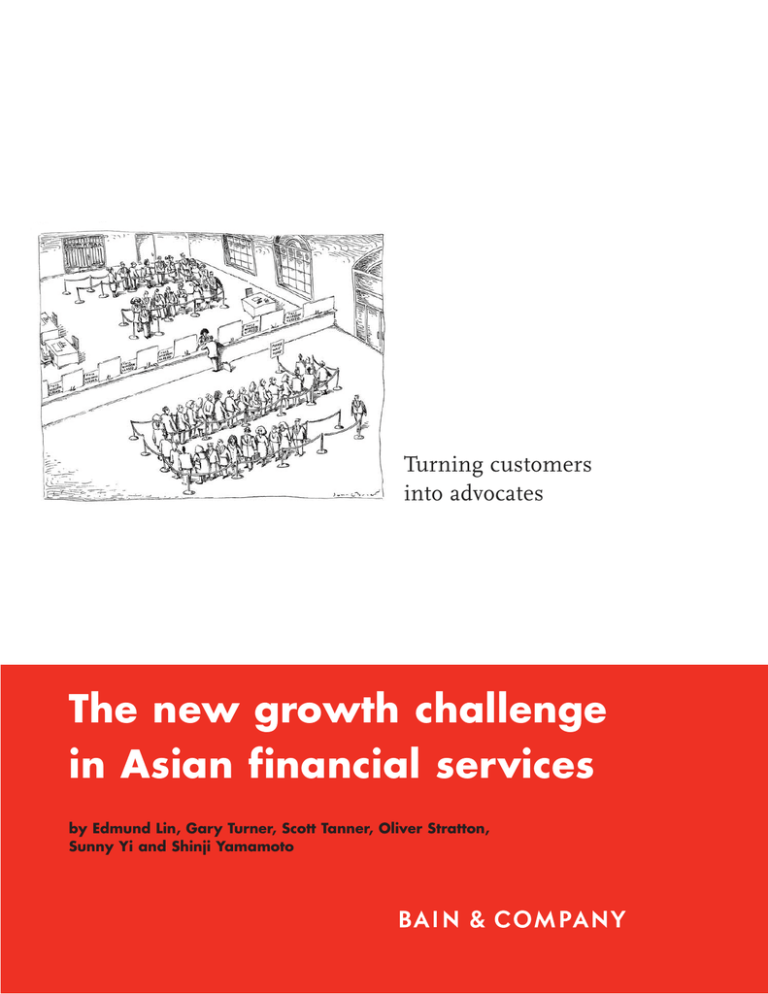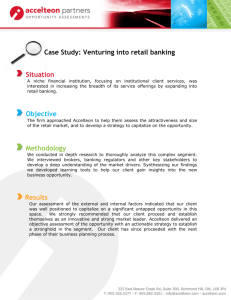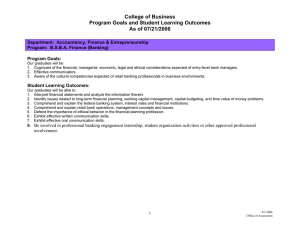
Turning customers
into advocates
The new growth challenge
in Asian financial services
by Edmund Lin, Gary Turner, Scott Tanner, Oliver Stratton,
Sunny Yi and Shinji Yamamoto
Edmund Lin is a partner based in Bain & Company’s Singapore office. Scott Tanner
and Gary Turner are partners in the firm’s Sydney office. Sunny Yi is a partner based
in Seoul. Oliver Stratton is a partner in Hong Kong and Shinji Yamamoto is a partner
in the firm’s Tokyo office. The authors lead Bain’s Asian Financial Services Practice.
Copyright © 2006 Bain & Company, Inc. All rights reserved.
Editorial team: Lou Richman and Elaine Cummings
Layout: Global Design
The new growth challenge in Asian financial services
Turning customers
into advocates
to rate, on a scale of zero to 10, “How likely are
you to recommend this company to a friend or
colleague?” Those responding with top scores
of 9 or 10 were classified as promoters; they’re
a company’s biggest fans and most loyal customers. Those answering with a 7 or 8 were
passives; they’re lukewarm about their customer experience. Those giving a score of 6
or less were detractors; this group is dissatisfied, vocal about it and driving away potential
new customers. Subtracting the percentage
of detractors from the percentage of promoters
yields a company’s Net Promoter® Score
(NPS)—a metric that provides an accurate
picture of consumers’ loyalty. The sobering
result: Customers in every market across the
region could not have been clearer about
their dissatisfaction. Among the 10 industries
we examined, financial services companies
across Asia and Australia ranked near or dead
last in customer ratings. (See Figures.)
As the race to win the hearts and wallets of
consumers in Asia heats up, financial services
companies still face an uphill climb: These
organizations are alienating customers and
undermining consumer loyalty across Asia
and Australia, according to recent surveys of
consumers in the regions. The findings of that
study, commissioned by Bain & Company, held
true in sector after sector. From retail banking
and mortgage lending to credit-card issuers
and every variety of insurance, these companies
are stunting their best prospects for growth.
All this floundering customer performance
comes at a time of unprecedented opportunity
and peril. In Japan, for instance, the financial
services industry is finally emerging from
a protracted restructuring. In Hong Kong,
Singapore, South Korea and Australia, deregulation, consolidation and cross-border mergers
are transforming financial services. And in
China, the opening of the sector later this
year to global competition under World Trade
Organization rules has set off a stampede
among international firms looking to invest
in local companies.
While Net Promoter Scores reveal that the
industry has a long way to go in pleasing consumers, the scores also point the way back
to customers’ good graces. The rewards of
taking that path are compelling. Companies
that anchor their growth plans to a loyal customer base consistently outgrow their peers.
That’s because, by definition, loyal customers
are less likely to shop for a better deal from
competitors. They purchase more of a company’s products and services. They spur growth
by enthusiastically talking up the company’s
To assess how the region’s financial service
providers are truly performing in the eyes of
their customers, we asked survey respondents
Figure 1: Australia
Retail banking
−46
5
−42
Life insurance
−31
−17
Home and contents insurance
−39
Home mortgage lending
Wealth management
−50
11
16
21
−2
49
−4
−31
−75
48
−8
−3
Motor insurance
−100%
= average
Range of NPS scores
−25
−8
0
11
25
50
75
100%
1
The new growth challenge in Asian financial services
Figure 2: China
= average
Range of NPS scores
Retail banking
−37
−100%
−75
−50
4
−25
products to their friends, and they take the
time to provide constructive feedback. Bain’s
analysis shows that a 5% increase in customer
loyalty can raise the long-term value of customer relationships by between 75% and 90%.
To convert detractors and passives into
promoters, successful financial services
companies master three disciplines:
•
First, they invest in customer relationships,
not just customer acquisition;
•
Second, they adapt to shifts in local market
conditions. In a region of vast cultural
diversity and evolving consumer tastes,
one size just doesn’t fit all;
•
Finally, they imbue the entire organization
with a passion for pleasing customers.
They design products that offer exceptional
value, deliver service their rivals cannot
match and develop customer insights
that enable them to refresh their offerings
again and again.
Invest in customer relationships,
not just customer acquisition
As Asia rode a tide of strong economic growth
and rising consumer prosperity, financial
services companies spent heavily to build
market share and expand their customer
base. For a long time, regulatory barriers
restrained foreign competitors, so domestic
banks, insurance companies and credit-card
issuers could count on holding consumers
captive once they acquired their business.
Now the scramble to sign up new customers
is reaching a point of diminishing returns.
2
0
34
25
50
75
100%
Deregulation and market saturation are
putting established customers in play for
poaching by rivals. Many financial services
firms have failed to adapt to the new realities. They’re still concentrating 80% or more
of their marketing expenditures on acquiring
customers and activating their accounts, even
though it usually takes two to three years to
recoup that investment.
Recent trends in Singapore’s crowded creditcard market highlight where such unbalanced
spending can lead. Served principally by a
half-dozen large domestic and international
banks, the relatively small Singapore market
is mature, leaving little room for card issuers
to grow other than by luring customers away
from their equally aggressive rivals. On average, Singaporean cardholders pack more than
five cards in their wallets, but no single issuer
holds a dominant share. The rivalry among
issuers—and the cost of recruiting new cardholders—has increased sharply in recent
years as high-powered foreign card issuers
like Citibank, HSBC and Standard Chartered
stepped up efforts to increase their presence.
United Overseas Bank (UOB) has taken
another tack. Rather than adding costly benefits indiscriminately, UOB tailored its card
offerings to serve the distinct needs of its best
customers. The bank’s market researchers
found that cardholders were more likely to
remain UOB customers, use their cards more
often and talk up the bank’s card with their
friends and colleagues if their cards came
with bonus perks. Based on this insight, UOB
launched and then steadily upgraded its comprehensive dining privileges program with
The new growth challenge in Asian financial services
discounts at a wide range of restaurants in
Singapore. In turn, cardholders rewarded UOB
with Singapore’s highest NPS—a positive 14%
versus an industry average of minus 15%.
Investing in customer relationships is also
a priority for companies trying to establish
a beachhead in Asia’s emerging markets,
especially China, where the potential rewards
for winning consumers’ favor are enormous.
Chinese savers hold some 325 million individual accounts, totaling nearly $1.8 trillion.
Anticipating the market opening, domestic
banks have been shoring up balance sheets,
and foreign competitors are staking out new
territory and spending on infrastructure. But
as important as these maneuvers are, banks
that aspire to win in China must also tend to
the essential work of cultivating a loyal customer base. Face-to-face interviews commissioned by Bain with 7,500 bank customers
in 20 major cities across China’s mainland
found that the country’s banking masses are
restless, and its consumers’ business is up
for grabs. China’s fast-growing population
of relatively affluent consumers—currently
some 75 million households with annual
incomes exceeding RMB 20,000 ($2,500)—
are an especially attractive but hard-to-please
group. They account for more than half of all
bank profits, but our survey found that as
incomes rise, these discriminating clients are
the likeliest to switch financial services providers.
China Merchants Bank is writing a new
script to capitalize on such opportunities.
Figure 3: Hong Kong
One of a new breed of national joint-stockcompany banks, the bank was overshadowed
by huge state-owned rivals that dominate
corporate lending. Its senior management
team recognized that it would have to set
the institution apart through innovation.
That approach is working. Though it is only
China’s sixth largest in terms of total assets,
China Merchants has become one of the nation’s
foremost issuers of credit cards, with 5 million
in circulation. Over the past three years, the
bank became one of the first to offer fixed-rate
mortgages, giving qualified applicants willing
to open long-term accounts the lowest borrowing rates in the industry. Through the end of
2005, customer deposits grew nearly 24% over
the prior year, to some $80 billion, and profits
grew at a double-digit rate. China Merchants’
president, Ma Weihua, expects retail revenues
to double as a proportion of total revenues, to
40% by 2010. In the Bain NPS study, China
Merchants garnered a solid score of 19%.
Adapt to shifting local market
conditions
As financial service companies move into new
markets, they quickly discover customers
with different tastes, needs and expectations,
and they learn that success in one market
does not guarantee the same result in another.
Net Promoter Score is not directly transferable from one market to the next. (In Japan,
for instance, customers only grudgingly hand
out high scores, while Australians are less
stinting in their praise.) Nor are the condi-
−59
−13
−64
Life insurance
−75
6
−50
7
−14
−43
Asset management
5
−22
−48
Credit cards
−100%
= average
Range of NPS scores
Retail banking
China’s fast
growing popu
lation of rela
tively affluent
consumers
accounts for
more than half
of all bank
profits, and
those customers
are the ones
most likely
to switch their
financial ser
vices provider.
−6
−25
−1
0
25
50
75
100%
3
The new growth challenge in Asian financial services
tions that create NPS leadership in a given
market fixed and permanent. But the scores
do help companies compare how they stack
up relative to the competition.
stores across the nation. What’s more, Shinsei
doesn’t saddle its customers with account
maintenance and ATM fees or transfer charges
common across the industry. Sixty-two percent
of Shinsei’s promoters cited the low- and nofee policies as the principal reason they would
recommend the bank to friends and colleagues.
Even in their home markets, banks have to
adapt to shifts in their industry’s competitive
landscape. In Japan’s retail banking market,
for example, nimble Shinsei Bank wins rare
plaudits, with an NPS of 7% versus an average
score of minus 69% for the sector overall.
The successor to the failed Long-Term Credit
Bank of Japan, Shinsei (the name means “new
life”) spent the past five years restructuring
operations with a goal of winning customer
trust and loyalty. The fruits of that effort are
ripening: Shinsei now has more than five
times as many promoters as its competitors.
How has it managed to do that? Though it
has one of the smallest branch networks in
the industry, Shinsei makes its presence felt
where it matters most in Japan. The bank
provides the greatest number of automated
teller machines in the Tokyo metro system,
in post offices and in 7-Eleven convenience
Build a customercentric organi
zation for longterm leadership
It takes commitment to build an organization
that excels year after year at cultivating customer
advocacy. Bain has found that companies
that are customer champions apply what we
call the “three Ds” of customer-led growth.
They start by identifying the customers they
understand best. Then they design unique
product offerings for them. They deliver on
their promises by focusing on flawlessly executing interactions with customers. Finally,
they continuously monitor their contact with
customers in real time and internalize that
feedback to develop their capacity to delight
customers again and again.
Figure 4: Japan (top), Singapore (bottom)
= average
Range of NPS scores
−75
Retail banking
Life insurance
−90
Motor insurance
−78
Credit cards
Consumer credit
−76
−100%
−61
−69
−82
−96 −86
7
−59
−41
−66
−41
−79
−75
−50
−25
0
25
50
= average
Range of NPS scores
−14
Retail banking
−45
Life insurance
Credit cards
4
−51
−100%
−75
−50
17
−33 −20
−44
Home loans
−1
100%
75
14
−15
−44
−27
−25
0
25
50
75
100%
The new growth challenge in Asian financial services
Figure 5: South Korea
−5
−31
Retail banking
−43
Life insurance
−26
−18 −7
Motor insurance
−75
−50
These are practices that Hang Seng Bank,
Hong Kong’s largest retail bank, has embedded
deep into its growth strategy. The bank places
customers at the core of its product and service
innovation process by engaging account holders
in an ongoing dialogue to uncover scores of
incremental ways to enhance the customer
experience. In early 2004, Hang Seng launched
its Customer Innovation Group (CIG), using
panels, phone surveys and an online forum to
let customers guide the bank’s product development. Participants in the CIG have generated numerous ideas for improvements across
a broad spectrum—from identifying a need
to quicken redemptions of credit-card bonus
points to changing how customers queue up
for service at branch offices to speed their
visits. The bank posts customers’ requests
on its website and responds to each. Giving
customers a voice has helped Hang Seng
earn the top NPS in Hong Kong’s banking,
life insurance and asset management sectors.
Delivering outstanding value to customers is
not just a prerequisite for steady growth, it can
also be a lifeline for survival during times of
industry upheaval. The experience of Korean
securities firms in the wake of the Seoul stock
market meltdown of 2000 and 2001 demonstrates the point. As share prices climbed in the
late 1990s, fueled by heavy trading by small
investors, the securities industry grew rapidly.
But as the market tanked and customers fled,
the brokerages discovered little that distinguished themselves from their cutthroat
−3
−18
−25
Securities
−25
16
−6
−6
−28
Credit cards
−100%
= average
Range of NPS scores
15
11
0
25
50
75
100%
competitors. Most chopped prices and tried
to shore up margins through round after
round of service cuts that caused still more
customers to defect. By 2004, the industry
was spiraling into a doom loop as the securities sector’s Net Promoter Score plunged to
an average of minus 60%.
Executives at Samsung Securities decided that
to pull out of this death spiral, they would need
to fundamentally change the firm’s relationship with customers. Instead of continuing to
shrink investment in customer service to hold
down costs, Samsung poured resources into
new technology that gave small investors
greater flexibility to manage their own accounts.
Order processing time fell from more than
three hours to less than 30 minutes. And
because the new technology enables Samsung
to track customers’ relationships with the firm
across all product and service channels, sales
reps are better able to target offers that serve
individual customers’ needs. The results have
been dramatic. Since 2004, Samsung raised
its NPS by 59 percentage points.
The Net Promoter approach is ultimately a tool
for business transformation, providing a single
measure for which every division, department
or individual in the company can be held
accountable. Consumers of financial services
across the Asia-Pacific region deserve no less,
and they will reward the banks, insurers, credit
companies and brokers that make customer
service their abiding mission.
Bain’s business is helping make companies more valuable.
Founded in 1973 on the principle that consultants must measure their success in terms
of their clients’ financial results, Bain works with top management teams to beat competitors
and generate substantial, lasting financial impact. Our clients have historically outperformed
the stock market by 4:1.
Who we work with
Our clients are typically bold, ambitious business leaders. They have the talent, the will
and the open-mindedness required to succeed. They are not satisfied with the status quo.
What we do
We help companies find where to make their money, make more of it faster and sustain
its growth longer. We help management make the big decisions: on strategy, operations,
technology, mergers and acquisitions and organization. Where appropriate, we work with
them to make it happen.
How we do it
We realize that helping an organization change requires more than just a recommendation.
So we try to put ourselves in our clients’ shoes and focus on practical actions.
For more information, please visit www.bain.com
© 1992 Danny Shanahan from cartoonbank.com. All rights reserved.
Amsterdam • Atlanta • Beijing • Boston • Brussels • Chicago • Dallas • Düsseldorf • Hong Kong • Johannesburg • London
Los Angeles • Madrid • Melbourne • Mexico City • Milan • Munich • New York • New Delhi • Palo Alto • Paris • Rome
San Francisco • São Paulo • Seoul • Shanghai • Singapore • Stockholm • Sydney • Tokyo • Toronto • Zurich





